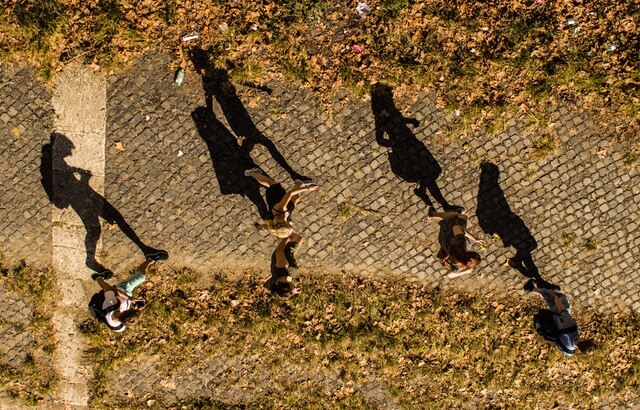By Julie Spangler
 As a parent, I recall the very special experience of watching my children learn about their world, often seeing myself in them, remembering how full of wonder the world really is. I saw a video the other day of a toddler seeing her shadow on the ground for the first time, and running screaming away from this dark thing that kept following her. I laughed to see it, of course, because it is funny from the perspective of people who know what this dark thing is. But from this child's perspective, it was terrifying. This is the way it is with the unknown and is why we spend so much time and effort avoiding it.
As a parent, I recall the very special experience of watching my children learn about their world, often seeing myself in them, remembering how full of wonder the world really is. I saw a video the other day of a toddler seeing her shadow on the ground for the first time, and running screaming away from this dark thing that kept following her. I laughed to see it, of course, because it is funny from the perspective of people who know what this dark thing is. But from this child's perspective, it was terrifying. This is the way it is with the unknown and is why we spend so much time and effort avoiding it.
The "shadow" has become a powerful meme in our modern culture. I think there are few, at least in the western world, who are not familiar with the idea of the shadow as a representation of the unconscious parts of our personality. Carl Jung is probably best known for his recognition of the shadow archetype as the representation of our 'dark side' -- all that we refuse to look at in ourselves. But it is has been well represented in our culture through the arts -- visual, theatrical and literary -- throughout history.
The Star Wars story may be the best known modern exploration of the shadow, with the innocent hero, Luke Skywalker, confronting his darker nature (represented by his father, Darth Vader) in order to win freedom. By understanding and accepting his dark side, he also redeems that of his father, freeing Darth Vader from the grip of his own shadow self.
But my favorite shadow story is one by Ursula LeGuin, The Wizard of Earthsea. This Wizard starts the story as a young man, Ged, who is born with a talent for magic, which earns him a place in the prestigious school for wizards on the famous Isle of Roke. (This school predated Hogwarts by some decades, I must say.) Now, Ged is young and inexperienced in the world, coming from a small village in the mountains. He knows little of the world, and even less about himself. Thus, when the unconscious elements of his personality rise up, he has little defense. He encounters another student at the school who while being older and of a higher birth has less talent. Both boys find themselves at the mercy of the little shadows we call jealousy and pride... of course denying both. These attributes are shoved into the background of their consciousness because they are threatening!
One sorry night, Ged is challenged by his rival to a magical competition during which Ged, trying to prove how powerful he is, opens a door into the shadow realms, and unleashes a dark power into the world. Ged is haunted by this shadow, running from it, fearing it, is disempowered by it, and finally realizes that he cannot leave it loose in the world. He must hunt it down.
Once he turns to hunt it, this fearsome thing runs! Until then Ged has been running from it in terror, and it has gained power over him. Suddenly when he faces it, it runs! Ged knows he must name this shadow in order to command it back into its place. The story takes him through many adventures as he hunts for the name of this thing. But in the end, upon catching up to the shadow being, Ged finally knows its name and names it - "Ged". The two step into each other and become one. Ged is whole and free.
I have used this story in classes, since it is a wonderful allegory for dealing with our own inner shadows. What we fear will have power over us, and we will spend much energy defending ourselves from it. What we deny will sneak up on us and take us by surprise. What we can become conscious of, what we can name, becomes part of our wholeness, part of our power.
A friend of mine told me of a dream she had a while ago which shows another way of approaching the shadow. She was being chased by a giant spider, running for her life. The spider was gaining on her and her terror drove her faster. Finally, recognizing that it was going to catch her, and she would die, she turned to face it. As she did, and started walking toward it, the spider grew smaller and smaller until she reached down and picked it up. Here was something that was actually a beautiful and fascinating creature. Another powerful image for handling these shadow parts of ourselves. Stop running, turn and truly look at it. What gift is there?
 As adults, we carry much from our past that is held as shadow. We have learned to be wary, to self-censor, and to fear. These are not attributes which encourage our light to shine. To be willing to take risks and surrender to the recognition that we are not perfect, to allow ourselves to see the flawed parts and name them, is to be freed from the past and to become new.
As adults, we carry much from our past that is held as shadow. We have learned to be wary, to self-censor, and to fear. These are not attributes which encourage our light to shine. To be willing to take risks and surrender to the recognition that we are not perfect, to allow ourselves to see the flawed parts and name them, is to be freed from the past and to become new.
It is that unencumbered newness which we so enjoy seeing in children. When my own son, Aidan, was a toddler, I had the pleasure of being present when he first saw his shadow. We were outside in the sun, and Aidan saw it on the garage door. He stopped in surprise, staring at this dark shape. He moved, it moved. He stopped, it stopped. He lifted his arms and the arms of the shadow rose too. He turned around and looked back, watching the shadow intently. He jumped and watched its feet lift off the ground. Then Aidan started to dance with it. I thought, "What a wonderful model for engaging with the shadow!"
Join Julie Spangler for a free one-hour teleclass on Standing in Presence. Click here for more information or to sign up.
